Traiskirchen
| Traiskirchen | ||
|---|---|---|
| ||
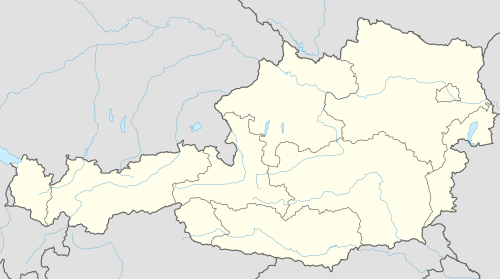 Traiskirchen Location within Austria | ||
| Coordinates: 48°1′N 16°18′E / 48.017°N 16.300°ECoordinates: 48°1′N 16°18′E / 48.017°N 16.300°E | ||
| Country | Austria | |
| State | Lower Austria | |
| District | Baden | |
| Government | ||
| • Mayor | Andreas Babler | |
| Area | ||
| • Total | 29.08 km2 (11.23 sq mi) | |
| Elevation | 200 m (700 ft) | |
| Population (1 January 2016)[1] | ||
| • Total | 18,515 | |
| • Density | 640/km2 (1,600/sq mi) | |
| Time zone | UTC+1 (CET) | |
| • Summer (DST) | UTC+2 (CEST) | |
| Postal code | 2514 | |
| Area code | 02252 | |
| Website | www.traiskirchen.gv.at | |
Traiskirchen is a town in the district of Baden in Lower Austria in Austria. It is 20 km south of Vienna and located in the famous Thermenlinie region of Lower Austria known for its wine and heurigers. Traiskirchen is home to the Traiskirchen Lions,[2] a team which plays in the Austrian basketball first league. The town has the oldest public observatory[3] in Lower Austria. The city is also nationwide and internationally known for its refugee camp the "Bundesbetreuungsstelle für Asylwerber".
Population
| Historical population | ||
|---|---|---|
| Year | Pop. | ±% |
| 1869 | 3,909 | — |
| 1880 | 4,380 | +12.0% |
| 1890 | 4,947 | +12.9% |
| 1900 | 6,011 | +21.5% |
| 1910 | 8,436 | +40.3% |
| 1923 | 8,139 | −3.5% |
| 1934 | 8,922 | +9.6% |
| 1939 | 8,908 | −0.2% |
| 1951 | 8,057 | −9.6% |
| 1961 | 9,247 | +14.8% |
| 1971 | 11,978 | +29.5% |
| 1981 | 14,063 | +17.4% |
| 1991 | 13,952 | −0.8% |
| 2001 | 15,669 | +12.3% |
| 2011 | 17,169 | +9.6% |
Refugee Camp (Bundesbetreuungsstelle für Asylwerber)
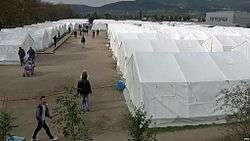
Traiskirchen is home of the largest refugee camp in Austria and one of the largest of these camps in the EU. The refugee camp is based in the centre of Traiskirchen on the area of the formally Imperial Artillery Cadet School[4] which was built in 1900. The Cadet School Traiskirchen could accommodate up to 340 cadets, 160 person staff and 110 horses (for riding lessons).

During the occupation of Austria a barrack of the Soviet army[5]( about 2000 Soviet armored troops ) and a hospital was housed in the former buildings until the autumn of 1955 .
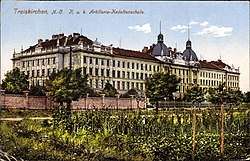
The buildings have been first used from the government as a refugee camp 1956 - 1960. The camp was used as a shelter for Hungarian refugees who left their country according to the Hungarian Revolution in November in 1956 for the first time. 113,810 people came to Austria on the 5th of the month and 6000 were taken to the camp in Traiskirchen. This was the first large use as a refugee camp and according to this act further decisions to host refugees from around the world were taken. The Federal Ministry of the Interior assigned an amount of 20 million Schilling (€1.45 million) for the renovation of the building substance on 8 March 1957. Even after the Prague Spring (1968 ) Czech and Slovak refugees were brought here. In the 1970s and 1980s, refugees mainly from Eastern Europe, but also from Uganda, Chile, Iran, Iraq, Vietnam have been accommodated. Many prominent refugees found initial reception here: The later Vienna State Opera Director Ioan Holender as well as the journalist[6] Paul Lendvai.
In May 1990 it was announced by the Mayor of Traiskirchen that according to promise of the Minister of the Interior the institute will be closed permanently . This plan was rejected because only a few refugees could be accommodated up elsewhere during the year 1990 and it was likely to accommodate new refugees from the Soviet Union in January 1991.
In 1993, the refugee camp was renamed the Asylum Office of the Federal Ministry of the Interior ("Bundesbetreuungsstelle für Asylwerber").
In 2015, as a result of the European migrant crisis, the Asylum Office in Traiskirchen had to admit a rising number of illegal immigrants. Due to heavy criticism by the press and civilians alike, Amnesty International inspected the facility on August 6, 2015.
More than 4500 people were accommodated by the end of July 2015. On August 5, one day prior to the inspection, the authorities declared a stop to further admittances. However, at the time of inspection circa 1500 people were unsheltered, amongst them more than 500 unattended children and teenagers.
According to the report, the conditions at the refugee camp are inhumane and unworthy of any human being: lack of staff and translators, lack of organization, food supply problems (two hours wait), terrible sanitary conditions, no separate sections for women and men, point system for punishment when fighting but also for complaints, resulting in spending several nights outside the facility.[7]
Issues
The refugee camp in Traiskirchen is always subject to political and media debates in Austria. The poor living conditions of refugees have been criticized. On the other hand, the inmates have been accused of dealing with drugs, property crimes and also violent crimes. The police is also often accused of conducting partly unlawful actions in raids inside and outside the camp.
Interior Minister Ernst Strasser outsourced the camp to the German company European Home Care In 2003. This (criticized)[8] contract was cancelled form the company in 2010 because of low occupancy of the camp.
Education
Kindergarden
- Kindergarden Möllersdorf Pestalozzi-Gasse
- Kindergarden Möllesdorf Schlössl
- Kindergarden Traiskirchen Bärenhöhle
- Kindergarden Traiskirchen Biberburg
- Kindergarden Traiskirchen Alfons Petzold
- Kindergarden Tribuswinkel Schloss
- Kindergarden Tribuswinkel Badner Straße
- Kindergaden Wienersdorf
- Oeynhausen Pfarrkindergarden from the church
Schools
Primary School
- Volksschule Möllersdorf
- Volksschule Tribuswinkel
- Volksschule Traiskirchen
The primery school in Traiskirchen is encircled by a fence for security purposes.
Secondary School
- Sport Middleschool Traiskirchen
School for Handycaped People
- Sonderschule Traiskirchen
Police Education School
The "Bildungszentrum der Sicherheitsexekutive (BZS)" Traiskirchen is an education institution for the Austrian police.
Issues
The percentage of foreigners in the secondary and primary schools sometimes exceeds 70% and is often discussed in the public. Traiskirchen has no highschool or college for higher education.
Sights
Franz-Koller Observatory
This observatory is the oldest in the state of Lower Austria and has been open to the public since 1967. It is unlike many observatories due to its location in the middle of the city and its low elevation, making it susceptible to the winter fog that plagues the region.
St. Nicholas Church
This church is notable for its age. It was built around the year 1400.
St. Margaret Church
The church was rebuilt in 1683 after the siege of Vienna based on its gothic foundations.
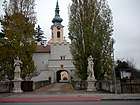
Lutheran Church
The church was built around 1900.
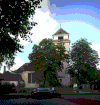
The Geldscheisser
The famous "Geldscheisser" is located in the city centre.

Malt Factory
The malt factory was owned by the banker Max Mauthner (born 22. Juli 1838 in Prague, † 28. Dezember 1904 in Vienna).

Castle of Moellersdorf
The castle was erected about 1690–1700 from Thomas Zachäus Czernin von und zu Chudenitz. About 1780 Joseph II redicated the facility to a casern.

Castle of Tribuswinkel
The founding is dated 1136, but earlier resourcers refer to 1120.
The weir would probably have been built as surrounding water castle around 1120-1230. The wall surrounding the castle and the moult is not existing anymore.[12]
Basketball
The town is home to the Traiskirchen Lions, 3-time Champion of the Österreichische Basketball Bundesliga. The team plays its home games in the Lions Dome.
Personality
- Joseph Fendi, the father of the painter Peter Fendi came from Traiskirchen
- Hans Seischab (1898-1965), professor of Business Administration
- Hellmuth Swietelsky (1905-1995), contractor
- Franz Kroller (1923-2000), director of the University Library Graz
- Otto Vogl (1927-2013), chemist
- Harald Neudorfer (born 1962), professor of propulsion technology
References
- ↑ Statistik Austria - Bevölkerung zu Jahresbeginn 2002-2016 nach Gemeinden (Gebietsstand 1.1.2016) for Traiskirchen.
- ↑ http://www.basket.at/ Traiskirchen Lions
- ↑ http://www.sternwarte-traiskirchen.org/ Franz Kroller Observatory
- ↑ http://anno.onb.ac.at/cgi-content/anno?apm=0&aid=nfp&datum=19031014&seite=25
- ↑ de:Flüchtlingslager Traiskirchen
- ↑ http://www.unhcr.at/mandat/fluechtlinge/prominente-fluechtlinge.html#c1644 Archived 2013-09-29 at the Wayback Machine.
- ↑ https://www.amnesty.at/de/view/files/download/showDownload/?tool=12&feld=download&sprach_connect=332
- ↑ http://no-racism.net/print/749/
- ↑ de:Traiskirchen Traiskirchen German wiki article
- ↑ de:Traiskirchen Traiskirchen German wiki article
- ↑ de:Traiskirchen Traiskirchen German wiki article
- ↑ de:Traiskirchen Traiskirchen German wiki article
External links
| Wikimedia Commons has media related to Traiskirchen. |
